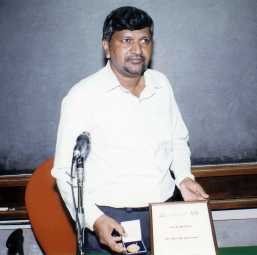The ICTP Prize in the field of Solid State Physics (in honour of Sir Nevill Mott) was awarded to A.M. Jayannavar from the Institute of Physics, Bhubaneswar, India.
Arun M. Jayannavar is an outstanding Condensed Matter physicist from India with internationally recognized achievements. He obtained his Ph.D. degree from the Indian Institute of Science in Bangalore in 1982. Later on he was a visiting scientist at the ICTP and a Humboldt Fellow in Germany. He joined the Institute of Physics in Bhubaneswar in 1991 as a Senior Lecturer, and now holds the position of Assistant Professor.
Jayannavar has made several original theoretical contributions in the broad area of physics of disordered and mesoscopic systems. Considering the Aharonov-Bohm geometry, he and his collaborators have found, surprisingly, that the magnitude of the persistent current in a loop connected to two reservoirs depends on the direction of the direct inter-reservoir current. He and his collaborators, in a pioneering study of superdiffusive quantum transport on dynamically disordered lattices, have corrected a long-standing conceptual error on this issue. He has given an important physical argument leading to a correct expression for the traversal time in tunneling which has important bearings on recent experiments. He and his collaborators have proposed an interesting novel mechanism for the c-axis transport in high Tc cuprates where the interlayer coherent tunneling is blocked by the decoherence due to the in-plane incoherent scattering. Recently, he has found a cross-over from single-parameter to two-parameter scaling in quasi-one-dimensional random systems.
For his significant achievements in physics, Jayannavar was elected Fellow of the Indian Academy of Sciences in 1996, and is one of its youngest members.
Jayannavar is a good example of an outstanding physicist being mainly trained and flourishing in a developing country. He has established a very active research group in disordered and mesoscopic physics at his own Institute and has achieved recognition in the Condensed Matter community of India. In his research work he has been following the example set up by Sir Nevill Mott of using first principles to grasp the essence of diversified phenomena without resorting to excessively technical formalisms.

















